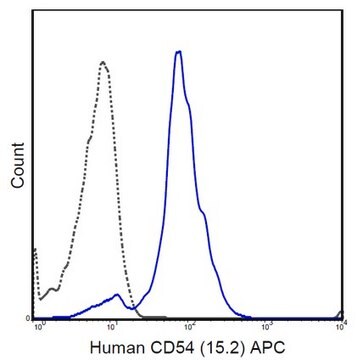MABE308
Anti-ICBP90/UHRF1 Antibody, clone 1RC1C-10
ascites fluid, clone 1RC-1C10, from mouse
Synonim(y):
E3 ubiquitin-protein ligase, inverted CCAAT box-binding protein, Nuclear protein 95, Nuclear zinc finger protein Np95, HuNp95, RING finger protein 106, Transcription factor ICBP90, Ubiquitin-like PHD and RING finger domain-containing protein 1, Ubiquitin
About This Item
Polecane produkty
pochodzenie biologiczne
mouse
Poziom jakości
forma przeciwciała
ascites fluid
rodzaj przeciwciała
primary antibodies
klon
1RC-1C10, monoclonal
reaktywność gatunkowa
human
metody
ChIP: suitable
immunocytochemistry: suitable
immunohistochemistry: suitable
western blot: suitable
izotyp
IgG1
numer dostępu NCBI
numer dostępu UniProt
Warunki transportu
wet ice
docelowa modyfikacja potranslacyjna
unmodified
informacje o genach
human ... UHRF1(29128)
Opis ogólny
Immunogen
Zastosowanie
Epigenetics & Nuclear Function
Chromatin Biology
Immunocytochemistry Analyisis: A representative lot from an independent laboratory detected ICBP90/UHRF1 in ICC (Hopfner, R., et al. (2001). Gene. 266(1-2)15-23.).
Immunohistochemistry Analysis: A representative lot from an independent laboratory detected ICBP90/UHRF1 in human appendix and human breast carcinoma tissues (Hopfner, R., et al. (2000). Cancer Res. 60(1):121-128.).
Chromatin Immunoprecipitation Analyis: A representative lot from an independent laboratory immunoprecipitated ICB90/UHRF1 in ChIP (Felle, M., et al. (2011). Nucleic Acids Res. 39(19). 8355-8365.)
Jakość
Western Blot Analysis: A 1:5,000 dilution of this antibody detected ICBP90/UHRF1 in 10 µg of HeLa cell lysate.
Opis wartości docelowych
Postać fizyczna
Przechowywanie i stabilność
Handling Recommendations: Upon receipt and prior to removing the cap, centrifuge the vial and gently mix the solution. Aliquot into microcentrifuge tubes and store at -20°C. Avoid repeated freeze/thaw cycles, which may damage IgG and affect product performance.
Komentarz do analizy
HeLa cell lysate
Oświadczenie o zrzeczeniu się odpowiedzialności
Nie możesz znaleźć właściwego produktu?
Wypróbuj nasz Narzędzie selektora produktów.
Kod klasy składowania
12 - Non Combustible Liquids
Klasa zagrożenia wodnego (WGK)
nwg
Temperatura zapłonu (°F)
Not applicable
Temperatura zapłonu (°C)
Not applicable
Certyfikaty analizy (CoA)
Poszukaj Certyfikaty analizy (CoA), wpisując numer partii/serii produktów. Numery serii i partii można znaleźć na etykiecie produktu po słowach „seria” lub „partia”.
Masz już ten produkt?
Dokumenty związane z niedawno zakupionymi produktami zostały zamieszczone w Bibliotece dokumentów.
Nasz zespół naukowców ma doświadczenie we wszystkich obszarach badań, w tym w naukach przyrodniczych, materiałoznawstwie, syntezie chemicznej, chromatografii, analityce i wielu innych dziedzinach.
Skontaktuj się z zespołem ds. pomocy technicznej